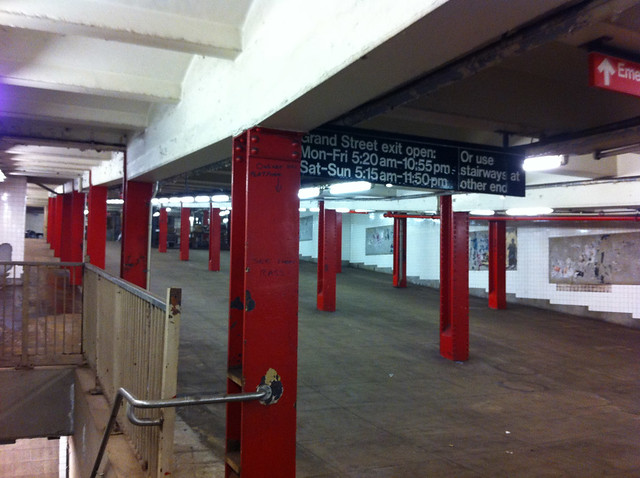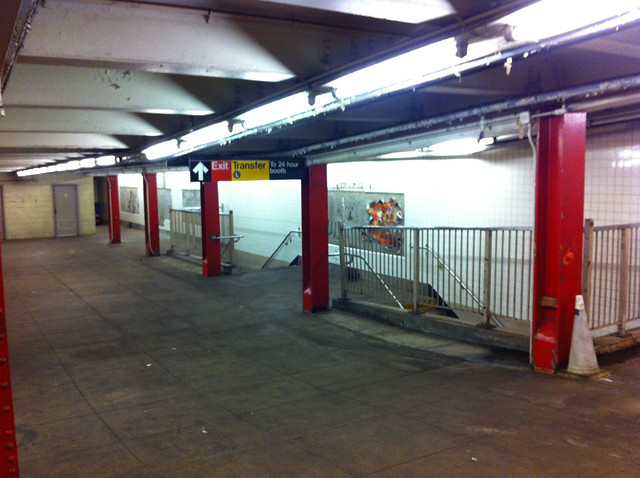 Once upon a time, the G train wasn’t a particularly popular train. The remnants of this era are still evident in the state of the line. Desolate, half-abandoned platforms that aren’t close to a state of good repair mark the line, and the way it shuffles back and forth between Queens and Brooklyn with nary a stop or even a tunnel in Manhattan lends it the air of being part of The Other.
Once upon a time, the G train wasn’t a particularly popular train. The remnants of this era are still evident in the state of the line. Desolate, half-abandoned platforms that aren’t close to a state of good repair mark the line, and the way it shuffles back and forth between Queens and Brooklyn with nary a stop or even a tunnel in Manhattan lends it the air of being part of The Other.
Yet, despite the mysterious sense of foreboding allure that surrounds the G train, it is both popular and reliable. It touches some of the more rapidly growing areas of Brooklyn and connects job centers in Long Island City and Downtown Brooklyn while skirting through residential neighborhoods. It comes reliably, if not often enough, and can be rather crowded during rush hour and, when running normally, on weekends.
Passing through or around various other subway lines, the G is also ripe for better connections to the rest of the city, and to that end, the Riders Alliance — an organization for which I sit on its board — has targeted the G for its first campaign. Its goals are rather simple: The Alliance is building grassroots support to pressure politicians and the MTA into adopting a few easy improvements for the G, including a free out-of-system transfer between the G and the J/M/Z and the G and the Atlantic Ave./Barclays Center station, increased train frequency at rush hour, improving communications with riders and reopening closed entrances.
At a rally on Sunday with approximately 75 riders, the Alliance and a few local politicians presented the requests and a letter to the MTA for a full line review similar to that conducted on the L and F lines over the past few years. The letter came from State Senators Daniel Squadron and Martin Malavé Dilan. “After calls to expand weekend L services to Williamsburg were made in 2011, the MTA discovered that transit riders are a reliable resource and know a thing or two about what improvements can be made, and where,” Dilan said in a statement. “These suggestions are worth looking into. And I hope the G Line can share the same success that came of the working relationship between the MTA and L riders last year.”
The letter expressed similar sentiments. “We ask,” it read, the MTA to “review schedules and ridership on weekdays and weekends, with the goal of creating a schedule that is more reflective of ridership patterns.” It is a modest request and one tough to turn down.
While the MTA hasn’t yet issued a full response to the letter, in a statement to The Wall Street Journal, Adam Lisberg offered a glimpse into the MTA’s thinking. “Our decisions to add service reflect on what we go out and measure,” he said. “What they’re calling for is not borne out by our numbers.”
And therein lies the MTA’s chicken-and-egg problem. First, the MTA sets its own load guidelines. If it doesn’t find the train crowded, that’s because its definition of crowded may not line up with yours or mine. (For what it’s worth, a train is full when every seat is taken and a quarter of the car is standing.) Second, the MTA has often said that demand doesn’t warrant more service, but it’s very possible that more frequent service will lead to greater demand. New Yorkers avoid the G train because they think it doesn’t run very often, they think waits are too long and they think trains are too crowded for the service. By changing perceptions and encouraging ridership, ridership will go up.
The G train has gotten better over the years but it could be more valuable. It could help feed riders off the L and to the M. It could serve as a true lifeline through growing neighborhoods. It could be a great way to travel in between Queens and Brooklyn without that annoying loop through crowded Manhattan stations. The MTA should give a nod to these possibilities and explore ways to make the G better.



 The MTA believes the current MetroCard system will be unsustainable and functionally obsolete by 2019, but a replacement effort is stuck in neutral with the agency aiming for a three- to five-year rollout time for the next-generation fare payment technology. With questions surrounding the widespread availability of bank-issued contactless credit or debit cards and a rapidly changing mobile payments, it is currently unclear what the eventual replacement for the MetroCard will be.
The MTA believes the current MetroCard system will be unsustainable and functionally obsolete by 2019, but a replacement effort is stuck in neutral with the agency aiming for a three- to five-year rollout time for the next-generation fare payment technology. With questions surrounding the widespread availability of bank-issued contactless credit or debit cards and a rapidly changing mobile payments, it is currently unclear what the eventual replacement for the MetroCard will be.

 (Overnights)
(Overnights)









 (42nd Street Shuttle)(Overnights)
(42nd Street Shuttle)(Overnights)

